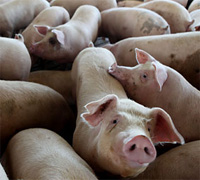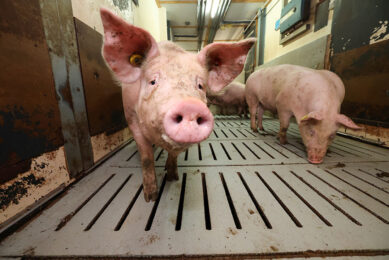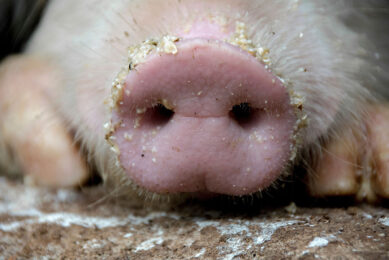PRRS breakthrough – reduced susceptibility in pigs

Building on work originally funded by the Pork Checkoff, a consortium of scientists from around the country has discovered a genetic marker in pigs that identifies whether or not a pig has a reduced susceptibility to porcine reproductive and respiratory syndrome (PRRS) – a disease that costs the US pork industry an estimated $664 million per year.
The researchers found agenetic marker, called a quantitative trait locus, on swine chromosome 4 that is associated with resistance to PRRS virus infection. According to Joan Lunney, a research scientist at the USDA’s Agricultural Research Service (ARS) in Beltsville, Md., this is especially important as this location also is associated with improved growth of pigs that are infected with the PRRS virus. She says results indicate a positive effect for PRRS resistance and higher weight gain.
“PRRS is one of the industry’s top ongoing issues, so this research discovery is a major step in the right direction,” said Lisa Becton, Checkoff’s director of swine health and information. “Pork producers realize that supporting science-based research is not an overnight proposition. It’s especially gratifying to achieve results like this and to envision how they can be implemented at the farm level.”
According to Chris Hostetler, Checkoff’s director of animal science, the identification of the marker gene responsible for increasing resistance to PRRS will allow genetics companies to more easily place selection pressure on PRRS resistance, which in turn, could allow producers to introduce new “PRRS-resistant” lines into their herds.
“This could be one of the tools used to help eliminate PRRS, but more importantly, this work may provide the platform for finding similar marker genes responsible for conveying resistance to other economically devastating diseases,” Hostetler said.
The research team that led to this marker discovery includes scientists at USDA’s ARS, Kansas State University and Iowa State University. The researchers continue to be funded by the PRRS Host Genetics Consortium, a nationwide effort originally funded by the National Pork Board; the Coordinated Agricultural Project program; the National Institute of Food and Agriculture and the U.S. Swine Genome Coordinator for the National Animal Genome Research Program.
To obtain the data necessary for the marker research, researchers collected blood and tissue samples, along with weight-gain data, from 2,000 pigs at biosecure facilities at Kansas State University. From there, ARS researchers performed genomic work at the facilities in Beltsville. Finally, Iowa State University researchers used the resulting genomic data to search the entire genome of all pigs from earlier trials done by the PRRS Host Genetics Consortium. They worked to identify chromosomal segments common to pigs that had lower levels of PRRS virus circulating in their blood and that grew faster after PRRS infection.
Now that scientists have found a chromosomal segment that can signify resistance to PRRS, the next step is to pinpoint the gene and determine whether it shows the same effects for other strains of the PRRS virus.
Checkoff-funded PRRS research results are available at pork.org.
Join 18,000+ subscribers
Subscribe to our newsletter to stay updated about all the need-to-know content in the pigsector, three times a week. Beheer
Beheer










 WP Admin
WP Admin  Bewerk bericht
Bewerk bericht